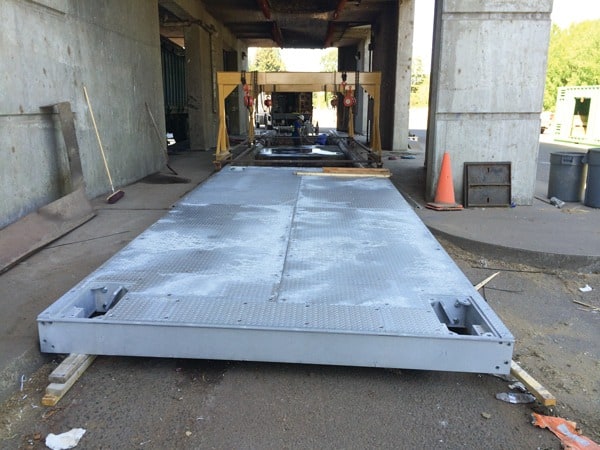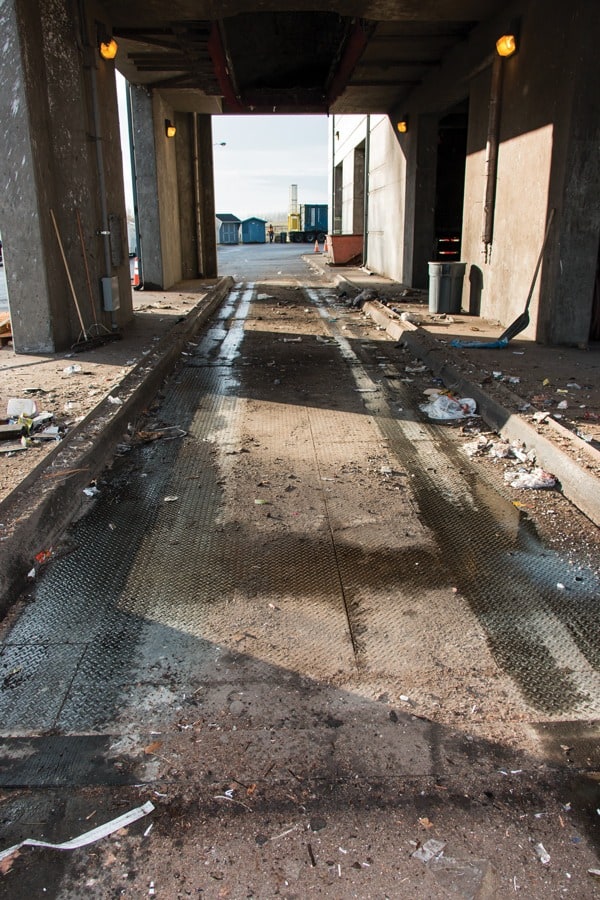A galvanized extreme-duty SURVIVOR® OTR truck scale with stainless steel, hermetically sealed load cells provides ultimate durability and performance in the highly corrosive solid waste environment.
By Caleb Olson
An invincible champion lurks in the Pacific Northwest. Lewis County, WA, is home to a custom Rice Lake Weighing Systems SURVIVOR® OTR truck scale like no other. Built to withstand the highly corrosive solid waste environment, where a seemingly endless stream of garbage trucks tests its mettle, this OTR is an augmented version of the already mighty Toughest Scale on Earth™. In the scale world, it is a legend.
OTR truck scales in similar environments typically feature beefy I-beams and a thick deck plate, which this model proudly incorporates—and takes one step further. The entire truck scale, including cover plates and load cell stands, are hot-dipped galvanized.
The Galvanizing Process and its History
Galvanization is a special process that bonds molten zinc to steel, forming layers of armored alloy that shield the material from corrosion. Invented in India in the fourth century, galvanization was first used in the construction of the Iron Pillar of Delhi, which still stands today—nearly 1,700 years later. The process has dramatically evolved over the centuries.
Rudimentary galvanic paint was traditionally used to fortify metal until hot-dip galvanization was invented in 1742, revolutionizing the process by immersing metal in molten zinc to create a uniform coating. In 1772, Luigi Galvani made another technological leap forward. While performing scientific experiments on frog cadavers, he discovered that electricity creates unusual results. First observing a simple muscle twitch in frog legs when electricity was applied, Galvani broadened his experiments to ultimately discover the electrochemical process that occurs between metals. In 1836, modern hot-dip galvanization was patented, and named after Galvani.
First, metal is cleaned with sulfuric acid and fluxed with ammonium chloride before being coated in liquid zinc at a temperature of 840 degrees Fahrenheit. This creates a strong, long-lasting bond between the metal and zinc, and completely insulates the metal from contact with the surrounding environment.
Making the Difference in Lewis County
 Before the galvanized OTR was installed, the Lewis County solid waste department was using a 20-year-old steel deck truck scale that had finally succumbed to the slow, unrelenting march of time. Solid waste is a difficult material to handle, and Lewis County’s equipment is expected to endure the test.
Before the galvanized OTR was installed, the Lewis County solid waste department was using a 20-year-old steel deck truck scale that had finally succumbed to the slow, unrelenting march of time. Solid waste is a difficult material to handle, and Lewis County’s equipment is expected to endure the test.
Collecting from both residential and business customers, the county has no way of knowing the contents of each garbage can or dumpster—and people throw away some pretty strange things. Usually, they are completely harmless; however, processing miscellaneous objects such as propane tanks, concrete highway dividers or objects containing chemicals can cause tremendous wear and tear on equipment. Heavy items create damaging collisions when loaded and transferred, combustible objects can explode, and chemicals from batteries, almost-empty household cleaning containers, and everything in-between mix together for an acid-like cocktail (called “leachate”) to attack equipment.
With no protective coating, the old scale was consumed by rust. Erratic readings and component lockups were becoming more frequent. It was time for an upgrade. To better serve the county, a scale designed for this environment and to fit the existing foundation, was needed. Lewis County called Steve Orr, President and Sales Manager of Scales Northwest.
“Working with Steve and everyone at Scales Northwest was amazing,” says Steve Skinner, Solid Waste Manager for Lewis County. “I’ve worked with other scale companies in the past, and Scales Northwest really knows the business inside and out. They were very professional and took care of all the measurements to make sure the scale fit our foundation. Ultimately, when the scale was installed, it fit perfectly.” Before installation, however, another integral component to extend the scale’s lifespan was put in place: a gantry system to move the scale platform for routine cleanout.
Track running along each side of the foundation was put in place. This allows a gantry crane to be positioned on each corner of the truck scale. Chain is attached to custom pick-hooks built into the OTR’s load cell pockets, and the entire scale deck is lifted and moved out of position for foundation cleanout. Every three months, the procedure takes place, and Lewis County has it down to a science.
“It only takes us two hours from start to finish,” says Bill Norwood, Solid Waste Operations Supervisor. “Because of the scale’s self-centering load cells, the procedure is pretty fast. When we’re done cleaning the pit, we can drop the scale back into position and it’s ready to go. There is no checking system we have to fiddle with. It just works.” Each SURVIVOR OTR features Rice Lake’s patented G-Force™ self-checking mounting system, which uses gravity to return the scale to center without check rods or bumper bolts. “Our old scale used canister-type load cells,” remembers Norwood. “We had to hold each load cell in place with a little pin while we tried to align everything. Rice Lake has a much better design.” For this application, stainless steel, hermetically sealed load cells were also used.
Rice Lake Weighing Systems is a family-owned, ISO 9001 certified corporation, and has been manufacturing and distributing weight-related products and supplies since 1946. Today, they are a global leader in measurement and automated process control. The company’s headquarters and main manufacturing plant are located in Rice Lake, WI with support facilities throughout the world, including North America, India and Europe.
The Toughest Scale on Earth

The entire system, consisting of two galvanized OTR truck scales and galvanized gantry tracks, was completed in the summer of 2015. The shining armor adorning the scales is a visual indicator of the durability that lies within. This durability is exercised on each load.
Because of the transfer process, the scales are subjected to more weight than dead load would indicate. When a truck dumps its contents on the “tipping floor,” located approximately 12 feet above the scales, a front-end loader pushes the solid waste to an opening in the floor. Beneath this opening, a container sitting atop the scale receives the payload. Those 12 feet might seem nominal, but the drop can create an impressive amount of velocity for heavy objects. When they hit the bottom of the container, a force far exceeding the weight (called “shock load”) is exerted on the scale. Then, an excavator compacts the material, creating an “aftershock.” It’s undoubtedly a job for the Toughest Scale on Earth.
To some, galvanizing a truck scale might seem like an extreme measure. Lewis County needed an exceptional solution for their environment. From leachate to shock loading, any scale would be put to the test. “The amount of steel that’s in that scale is incredible,” says Skinner. “We joke that it would last 30 years without galvanization, so we estimate it’ll last exponentially longer with it. That scale will still be here after I’m long retired.” Not every scale could withstand this environment—only a SURVIVOR.
Caleb Olson is Marketing Editor for Rice Lake Weighing Systems He can be reached at (800) 472-6703 or via e-mail at [email protected].
